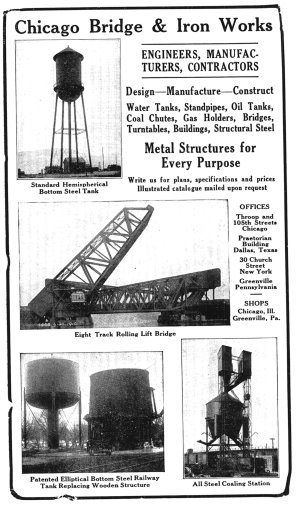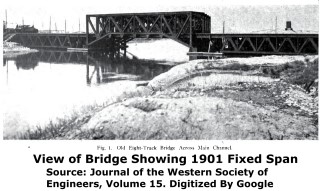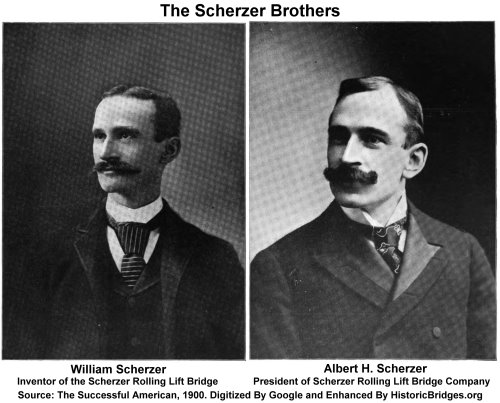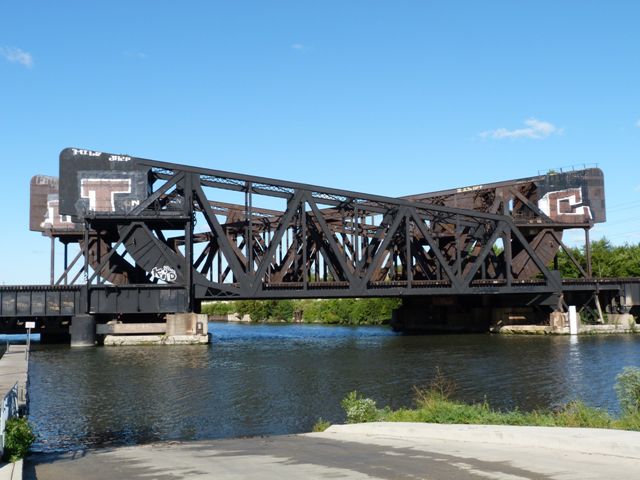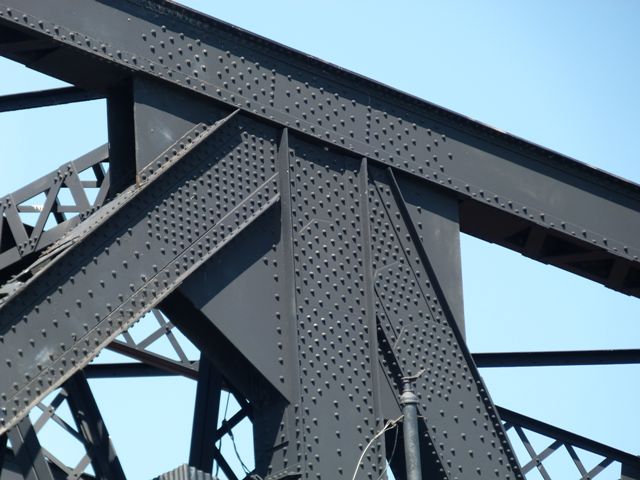We Recommend:
Bach Steel - Experts at historic truss bridge restoration.
BridgeHunter.com Phase 1 is released to the public! - Visit Now
Eight Track Bridge
Western Avenue Railroad Bridges 'Scissors Bridges'
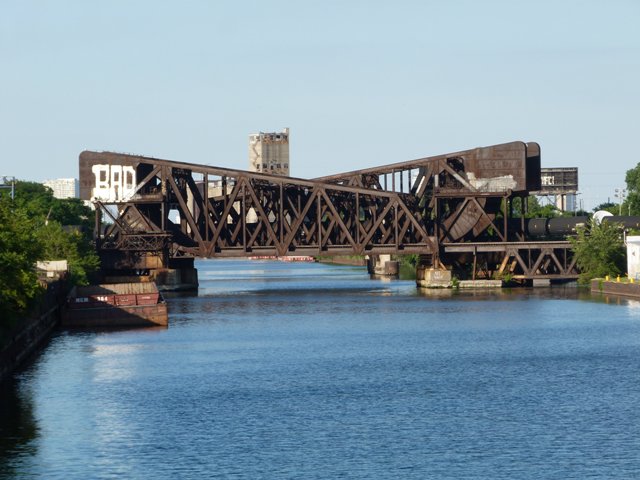
Primary Photographer(s): Nathan Holth
Bridge Documented: August 12, 2006 and 2011-2012
Chicago: Cook County, Illinois: United States
Metal Rivet-Connected Warren Through Truss, Movable: Single Leaf Bascule (Rolling Lift) and Approach Spans: Metal Rivet-Connected Warren Deck Truss, Fixed
1909 By Builder/Contractor: Chicago Bridge and Iron Works of Chicago, Illinois and Engineer/Design: Scherzer Rolling Lift Bridge Company of Chicago, Illinois
Not Available or Not Applicable
140.0 Feet (42.7 Meters)
140.0 Feet (42.7 Meters)
Not Available
1 Main Span(s) and 2 Approach Span(s)
Not Applicable

View Information About HSR Ratings
Bridge Documentation
View Historic American Engineering Record (HAER) Documentation For This Bridge
HAER Data Pages, PDF
View A Detailed Construction History of This Bridge From The 1909 Journal of the Western Society of Engineers, Volume 15
View An Article About This Bridge From Railway Age Gazette, 1910
View A Historical Article About This Bridge's Electrical Systems
View A Short Historical Article About This Bridge
View A Short Biography of Horace E. Horton of Chicago Bridge and Iron Works
Above: 1916 advertisement that also has a rare photo showing one of the spans of this bridge raised.
2015 Update: Rehabilitation, Alteration, and Reopening of Western Half of Bridge
After being abandoned for many years, something that rarely happens in the railroad world these days has occurred with this bridge in 2015. The abandoned tracks are being rebuilt and reopened! As part of this work, the long-abandoned western half of this bridge is being extensively rehabilitated. It is a very interesting chapter in the history of this unusual bridge, and its rehabilitation will ensure that the bridge is not at risk for demolition anytime in the near future. There is one major downside however, because the 1901 deck truss approach spans were removed and replaced with modern plate girders as part of this project. The below photo showing the project in process (with one of the deck truss spans removed) is shown below. Click the photo for enlargement.
Photo By Patrick T. McBriarty.
About This Bridge
Here, there are four bridges side by side, each carrying two tracks each. They are among the most unusual of the movable bridges in the greater Chicago area, and have a unique appearance to them. The bascule truss spans seen today were built in 1909-1910 by the Chicago Bridge and Iron Works. There is a colorful history behind these bridges. The bridge was originally built in 1901 as an unusual fixed bridge that was designed to be converted into a double-leaf bascule bridge in a number of years, when movable bridges would be required on the canal. When the time came to convert to a movable bridge however, it turned out to be just as cost effective to build a new bridge and so the existing single leaf bascule spans replaced the 1901 span. The 1901 approach deck truss spans remained in use. Today, one of the bridges has had its deck truss spans replaced, but the deck trusses remain on other bridges. Follow the historic The Journal of the Western Society of Engineers Link to find a fascinating, detailed article that discusses the history of the bridge, has photos showing its construction, and includes photos of some original plan sheets.
In their page for the nearby Western Avenue Bridge, the Historic American Engineering Record calls these unusual railroad bridges, which are nearby the Western Avenue Bridge, the "Scissors Bridges." Such a nickname seems appropriate since they do have a scissors-like look to them, which is because the machinery end (the end with the counterweights), of the four bridges are not all on the same side. The crossing was traditionally known as the Eight Track Bridge however. The trusses on the bridge employ a Warren truss configuration, and there are riveted connections present on the bridge.
Above, a historical drawing from Marine Review shows what the original 1900 bridge would have looked like in the raised position if it had actually been converted into a bascule as originally planned.
During the decision making period that resulted in the fixed span being replaced completely with the bascule span seen today, the Scherzer Rolling Lift Bridge Company's rival, Joseph Strauss of the Strauss Bascule and Concrete Bridge Company, came forward with an alternate proposal to remove the fixed span and erect a Strauss trunnion bascule bridge. Unsurprisingly, Strauss felt that rolling lift bascule bridges were the worst sort of bridge imaginable and Strauss trunnion bascule bridges were the solution to every movable bridge problem to be found. Obviously, in the case of this bridge, the proposal Strauss made was ultimately rejected. However, the text of the letter he wrote to the Board of Trustees of the Sanitary District of Chicago, available in the box below, is an interesting look into the rivalry between Strauss and Scherzer.
Letter to the Board of Trustees of the Sanitary District of Chicago
from Joseph Strauss
|
Thanks to Tom Winkle for providing boat transportation to assist in the photo-documentation of this historic bridge.
|
Sanitary District Plaque ERECTED BYTHE SANITARY DISTRICT --- OF --- CHICAGO ----- 1909 ----- PRESIDENT ROBERT. R. MC CORMICK BOARD OF TRUSTEES WILLIAM H. BAKER ADOLPH BERGMAN WALLACE G. CLARK HENRY F. EIDMANN PAUL. A. HAZARD THOMAS J. HEALY ROBERT. R. MC CORMICK EDWARD I. WILLIAMS CHIEF ENGINEER GEORGE M. WISNER BRIDGE ENGINEER C. R. DART BUILT FOR THE C. J. RY. CO. |
Builder Plaque SCHERZER ROLLING LIFT BRIDGEINVENTED BY WILLIAM SCHERZER, C. E. PATENTED DEC. 26TH, 1893. PATENTED MAY 1, 1900. JUNE 19, 1900. NOV. 5, 1901. NOV. 5, 1901. JAN. 27, 1903. MAR. 3, 1908. AUG. 4, 1903. FEB 16, 1904. PATENTS ALLOWED AND PATENTS APPLIED FOR THE SCHERZER ROLLING LIFT BRIDGE CO. CHICAGO, 1909 |
Information and Findings From Chicago Landmarks DesignationGeneral Information Address: South of 31st St., West of Western Ave.
(Chicago Sanitary and Ship Canal) This Bridge Is A Designated Chicago Landmark |
![]()
Historic Bridges of Chicago and Cook County


Chicago and Cook County are home to one of the largest collections of historic bridges in the country, and no other city in the world has more movable bridges. HistoricBridges.org is proud to offer the most extensive coverage of historic Chicago bridges on the Internet.
General Chicago / Cook County Bridge Resources
Chicago's Bridges - By Nathan Holth, author of HistoricBridges.org, this book provides a discussion of the history of Chicago's movable bridges, and includes a virtual tour discussing all movable bridges remaining in Chicago today. Despite this broad coverage, the book is presented in a compact format that is easy to take with you and carry around for reference on a visit to Chicago. The book includes dozens of full color photos. Only $9.95 U.S! ($11.95 Canadian). Order on Amazon.
Chicago River Bridges - By Patrick T. McBriarty, this is a great companion to Holth's book shown above. This much larger book offers an extremely in-depth exploration of Chicago's movable highway bridges, including many crossings that have not existed for many years. Order Now Direct From The Publisher! or order on Amazon.
View Historic American Engineering Record (HAER) Overview of Chicago Bascule Bridges (HAER Data Pages, PDF)
Chicago Loop Bridges - Chicago Loop Bridges is another website on the Internet that is a great companion to the HistoricBridges.org coverage of the 18 movable bridges within the Chicago Loop. This website includes additional information such as connections to popular culture, overview discussions and essays about Chicago's movable bridges, additional videos, and current news and events relating to the bridges.
Additional Online Articles and Resources - This page is a large gathering of interesting articles and resources that HistoricBridges.org has uncovered during research, but which were not specific to a particular bridge listing.
![]()
Photo Galleries and Videos: Eight Track Bridge
Structure Overview
Original / Full Size PhotosA collection of overview photos that show the bridge as a whole and general areas of the bridge. This gallery offers photos in the highest available resolution and file size in a touch-friendly popup viewer.
Alternatively, Browse Without Using Viewer
![]()
Structure Details
Original / Full Size PhotosA collection of detail photos that document the parts, construction, and condition of the bridge. This gallery offers photos in the highest available resolution and file size in a touch-friendly popup viewer.
Alternatively, Browse Without Using Viewer
![]()
Structure Overview
Mobile Optimized PhotosA collection of overview photos that show the bridge as a whole and general areas of the bridge. This gallery features data-friendly, fast-loading photos in a touch-friendly popup viewer.
Alternatively, Browse Without Using Viewer
![]()
Structure Details
Mobile Optimized PhotosA collection of detail photos that document the parts, construction, and condition of the bridge. This gallery features data-friendly, fast-loading photos in a touch-friendly popup viewer.
Alternatively, Browse Without Using Viewer
![]()
Maps and Links: Eight Track Bridge
Coordinates (Latitude, Longitude):
Search For Additional Bridge Listings:
Bridgehunter.com: View listed bridges within 0.5 miles (0.8 kilometers) of this bridge.
Bridgehunter.com: View listed bridges within 10 miles (16 kilometers) of this bridge.
Additional Maps:
Google Streetview (If Available)
GeoHack (Additional Links and Coordinates)
Apple Maps (Via DuckDuckGo Search)
Apple Maps (Apple devices only)
Android: Open Location In Your Map or GPS App
Flickr Gallery (Find Nearby Photos)
Wikimedia Commons (Find Nearby Photos)
Directions Via Sygic For Android
Directions Via Sygic For iOS and Android Dolphin Browser
USGS National Map (United States Only)
Historical USGS Topo Maps (United States Only)
Historic Aerials (United States Only)
CalTopo Maps (United States Only)

